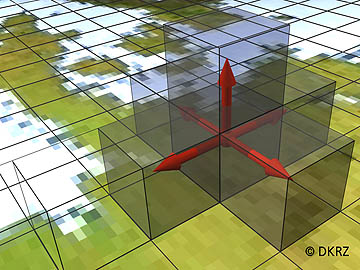Climate research is, in the first place, basic research. A primary target is the understanding of the physical and statistical properties of the weather, and ultimately, the ability to realistically simulate the climate for long periods. In contrast to weather forecasting (see e.g. Deutscher Wetterdienst), where comprehensive observation data are needed as initial conditions for the simulations, long term simulations of the climate system require proper boundary conditions and need to include processes in and interactions between atmosphere, ocean, ice and the land surface.
However, the individual parts of the climate system are characterized by widely differing time scale ranges. This disparity makes it impossible to represent all important components of the climate system simultaneously within a single comprehensive model. Therefore, a hierarchy of climate models must be developed for different applications involving different time scales and combinations of subsystems.
Building a climate model
Processes in the climate systems are governed by known laws of nature and can be expressed as mathematical equations, as, for example:
- Conservation of mass
- Conduction of heat
- Equation of motion
 However, since it is impossible to solve these equations directly, climate researchers have been developing numerical models from these equations that can be solved by approximation using computers.
However, since it is impossible to solve these equations directly, climate researchers have been developing numerical models from these equations that can be solved by approximation using computers.
 First, the different parts of the climate system, e.g. the atmosphere, land surface, sea ice, and oceans, must be skillfully divided into millions of grid cells (see figure on the right hand side).
First, the different parts of the climate system, e.g. the atmosphere, land surface, sea ice, and oceans, must be skillfully divided into millions of grid cells (see figure on the right hand side).
The evolution of climate properties such as temperature or the amount of water vapor within each grid box and the transport of these quantities between the boxes must be individually calculated using supercomputers. This process is highly complex, requiring not only a thorough understanding of the physical processes, but also great skills in supercomputer programming. The smaller the boxes and the more processes that are calculated, the better the representation of real world climate.
DKRZ acts as a "laboratory" for all German climate researchers working with climate models. Accordingly, DKRZ's hardware and services are specifically tailored to complex simulations with numerical models of the climate system. The experiments can be effectively computed, and the extensive results can also be analyzed and finally archived within DKRZ's high performance computing environment.
